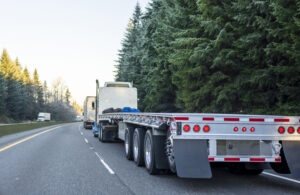As an owner-operator, it is important to transport goods safely, on time, and undamaged. Not only how your shipment arrives is important, but also using the correct equipment. In the trucking industry, not one trailer alone will fit your needs. There are many different trailers for different weights, heights, and configurations, depending on the type of freight being hauled. It is important to understand the different types of trailers for your load and use them correctly.

Types of Trailers
There are many different types of trailers for different types of freight. Below is a list of common trailer types and what these trailers are used for.
Flatbed
Flatbed trailers are used to haul heavy shipments such as lumber or large equipment. Flatbed trailers are used for freight that cannot be damaged by weather conditions because even if you use a tarp, goods can be damaged if not appropriately covered. Flatbeds can hold up to 48,000 pounds and are between 48 – 53 feet long.
Flatbed Specifications:
Length: 48 – 53 feet long
Width: 8ft 6in
Deck Height: 60in
Weight: 48,000 lbs
Dry Van
Dry van trailers or enclosed trailers are enclosed and are commonly used out on the road. Typically, drivers haul freight that risks being damaged by different weather elements. Dry van trailers can be used in all types of weather conditions.
Dry Van Specifications
Length: 48 – 53 feet
Inside Width: 8ft 2in
Inside Height: 8ft
Weight: 45,000 – 46,500 lbs
Refrigerated
Refrigerated trailers or reefer trailers are used when hauling items that need to be frozen or cooled. This trailer is often used for food. When using a refrigerated trailer, drivers must keep a close eye on the temperature and condition of the trailer.
Refrigerated Specifications
Length: 48 – 53ft
Width: 8ft 2in
Height: 8ft
Weight: 42,000 – 45,000 lbs
Step-Deck and Lowboy
Step-deck and lowboy trailers are used when the trailer and freight are too tall for a normal flatbed trailer. In combined trailers, the upper height limitations are 11.5 ft. However, in step-deck trailers, the highest height is lowered by two feet, allowing for legal clearance.
Step-Deck Specifications
Length: 48 – 53ft (the top deck is 11ft long)
Width: 8ft 6in
Deck Height: 60in the top deck and 42in the bottom deck
Weight: 43,000lbs
Step-Deck and Lowboy
Step-deck and lowboy trailers are used when the trailer and freight are too tall for a normal flatbed trailer. In combined trailers, the upper height limitations are 11.5 ft. However, in step-deck trailers, the highest height is lowered by two feet, allowing for legal clearance.
Step-Deck Specifications
Length: 48 – 53ft (the top deck is 11ft long)
Width: 8ft 6in
Deck Height: 60in the top deck and 42in the bottom deck
Weight: 43,000lbs
Removable Goosenecks
A removable gooseneck trailer or RGN can haul taller and heavier loads. These trailers are used when you need to haul equipment that falls over the legal height limit. RGN trailers can hold up to 150,000lb and have up to 20 axles. However, if you have a larger load, you can opt to use the Extendable RGN trailer. However, if you choose to use the Extendable RGN trailer, you will need to have a special permit.
Removable Gooseneck Specifications
Length: 24 – 29ft
Width: 8ft 5in
Deck Height: 18 – 24in
Weight: 42,000lbs
While there are many different trailer options, and it can be hard to determine the best trailer to use, leasing on with a reputable trucking company can help you decide on the best trailer for your load. With Landstar, while you are your own boss and run your own business, you are not completely alone. Landstar stands behind owner-operators who choose to lease with Landstar.

